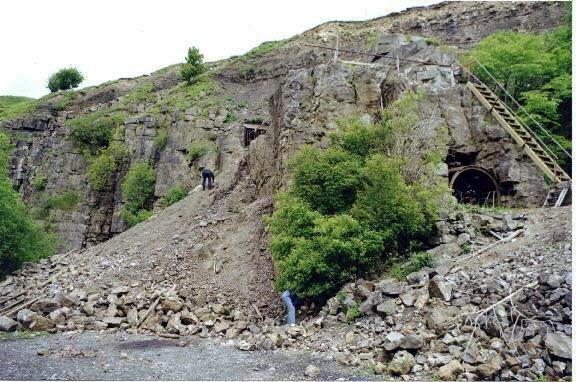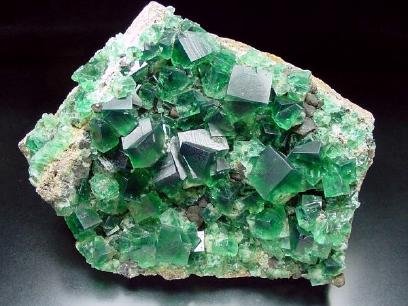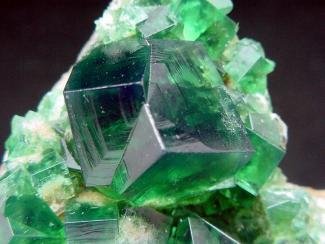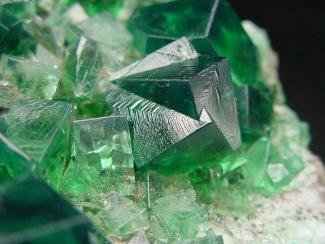

The Rogerley mine is located in a disused 19th century limestone quarry in the historic Weardale mining district of northern England. Mining in the region dates back to the 12th century, first for lead and later fluorspar, and many mines in the Dale, including the Heights, Boltsburn, Blackdene, Cambokeels, and Frazer’s Hush are famous for their past production of fine specimens of fluorite and other minerals. The Rogerley mine was first discovered in the early 1970’s by partners Lindsay Greenbank and Mick Sutcliffe, and is, to date, the only mine in the UK to be operated on a commercial basis solely for mineral specimens. The partners worked the mine on weekends through the early 1990’s, producing a limited, but steady stream of high quality green fluorite specimens.  The Rogerley Mine seen from below the dumps, May, 2000. Upon retiring from mining in 1996, the partners offered to assist in transferring operation of the Rogerley mine to a group of interested Americans, who began full time mining at in May 1999. The mine had been idle for several years and the high rainfall in Weardale, along with periodic break-ins by highgraders had caused considerable deterioration. After completely rehabilitating the mine, the crew began tunneling, and on June 12 they found a major cavity lined with green fluorite. Excavation of what became known as the Black Sheep Pocket lasted through the summer, and the miners collected hundreds of high quality specimens. The crew used a hydraulic-powered diamond chain-saw to cut the rock surrounding the pocket, which allowed the recovery of many large, undamaged specimens. A second series of cavities produced large, opaque purple fluorite crystals coated with a quartz druze. This became known as the Weasel Pocket after a former inhabitant of the mine who was forced to vacate on very short notice (Fisher and Greenbank, 2000). The mine has been successfully reopened during each summer since, and plans to reopen during 2003 are currently proceeding. During the 2000 mining season a new tunnel was driven to intersect the mineralized zone to the east of the Black Sheep Pocket of the previous summer. After driving approximately 15 meters of tunnel the mineralized zone was again encountered. Collecting in this zone proceeded through the summer and by late August the miners had encountered the rear of the previous year’s pocket. In 2001 mining focused on both continuing the eastern tunnel of the year before, and new development in the original western tunnel. In the eastern tunnel the Birthday Pocket was discovered, which produced many large plates of deep emerald green fluorite crystals. In the western tunnel the Solstice Pocket (discovered on June 21) also produced some very attractive specimens. Toward the end of the mining season a short exploratory tunnel driven westward from the western tunnel encountered another mineralized zone. This drift, known as the West Cross Cut produced some excellent specimens of green fluorite with galena, and hopes are high that it will continue to produce in the coming season. During the 2002 collecting season work focused on both extending the east tunnel and continued development of the West Cross Cut. By late August the east tunnel has encountered the rear of the Solstice Pocket and now joined back with the western tunnel. Along the way a side pocket known as The Dipper produced some very nice, and often large plates of limestone matrix covered with green fluorite crystals. During the summer a small gallery of connecting tunnels was created in the West Cross Cut, and this area yielded some exquisite fluorite specimens – perhaps the best yet found in the mine. The Weardale mining district is located within the Northern Pennine Orefield, a fault-bounded block of Carboniferous sediments covering an area of approximately 1200 square kilometers (Dunham, 1990). Mineralization of the Northern Pennine Orefield occurred through the emplacement of near vertical epigenetic hydrothermal ore-bearing veins along a set of regional fractures trending ENE and WNW. Horizontal metasomatic replacement deposits, known as “flats” occur adjacent to many veins in certain strata, and appear particularly well developed near vein intersections. The majority of the flats in Weardale occur in the Great Limestone, which forms the base of the Upper Carboniferous series, and it is cavities within the flats, which have produced most of the well-crystallized specimens recently found in the Rogerley mine. Fluorite from the Rogerley mine commonly occurs as penetration twins on {111}, though crystals larger than 4 cm are often untwinned. Crude octahedral galena crystals, up to 1 cm often accompany the fluorite. Fluorite from the Rogerley (and other mines in Weardale) is well known for its unique daylight fluorescence, which gives the fluorite a purple glow in direct sunlight. This fluorescence has been attributed to the presence of a suite of rare earth element in the crystal structure of the fluorite (Bill et al, 1967, Dunham, 1990). Recent analyses of fluorite from the Rogerley Mine have confirmed that it contains elevated amounts of a number of these elements, including lanthanum, cerium, and yttrium (Falster et al, 2000).  A group of twinned fluorite crystals, up to 2.5 cm in size, on silicified limestone matrix. Specimen was collected in 2002 from the West Cross Cut. Operating a mine for mineral specimens is a much more difficult undertaking than casual collecting, requiring considerable technical skill, and the investment of much time and money. It is also a test of the partner’s ability to get along with each other under stressful conditions. Ultimately, there is no guarantee of financial success as no one can ever truly predict what a mine will give you. However, given the right mix of personalities, sufficient funding, and a property with good potential, such operations can be highly successful. With the decline of traditional mining activities in Western Europe and North America, future production of mineral specimens from historic locations such as Weardale now depends on operations like the Rogerley.  Well-formed fluorite twins up to 2 cm on edge, covering the face of the limestone matrix. The larger crystals are completely lustrous and transparent. Collected during the summer of 2001. Please note: The Rogerley Mine is on private property and closed to collecting by the general public. Visitors in small groups are generally welcome, but must make prior arrangements with the author. For more information on the Rogerley and other fluorite mines in Weardale please see our website at: www.ukminingventures.com  Gemmy, lustrous, deep green fluorite twins up to 1.5 cm. Collected summer, 2001. References Bill, H., Sierro, J., and LaCroix, R., 1967, Origin of coloration in some fluorites. American Mineralogist, 52, 1003-1008. Dunham, K. C., 1990, Geology of the Northern Pennine orefield, v. I, 2nd Ed. British Geological Survey, London, 299 p. Falster, A.U., Fisher, J., and Simmons, W.B., 2000, REE content and fluorescence in fluorite from the Rogerley Mine, Weardale, County Durham, England(abs.). Proceedings of the 27th Annual Rochester Mineralogical Symposium, Rochester, New York, April 13-16, 2000. Fisher, J., and Greenbank, L., 2000, The Rogerley Mine, Weardale, County Durham, England, Rocks & Minerals, 75(1), 54-61. Fisher, J.E., et L. Greenbank, 2000, La Mine Rogerley, Weardale, comte de Durham, Angleterre. Le Regne Mineral, 34, 5-14. (in French) |
